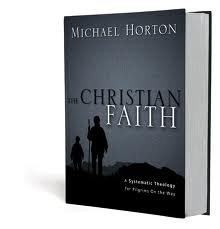Reading Reflection:

August 15, 2012
 The Christian Faith, Michael Horton (Zondervan, 2011)
Since I was emphasizing the covenant aspect of God’s Word in my last book review, I wanted to share an excerpt from Michael Horton’s The Christian Faith, where he dedicates a whole chapter to this idea. Obviously, I can’t share the whole chapter, so I highly recommend this award-winning book for study.
The Christian Faith, Michael Horton (Zondervan, 2011)
Since I was emphasizing the covenant aspect of God’s Word in my last book review, I wanted to share an excerpt from Michael Horton’s The Christian Faith, where he dedicates a whole chapter to this idea. Obviously, I can’t share the whole chapter, so I highly recommend this award-winning book for study.
Every covenant has a canon (meaning “rule”), and every community is defined by its constitution. As the word suggests, such a document actually constitutes a nation or company. In recent decades, parallels between ancient Near Eastern (especially Hittite) treaties and biblical covenants have been explored with remarkable results. In many cases, the greater ruler (suzerain) would unilaterally impose conditions on a lesser ruler (vassal), and a copy of the treaty was deposited in the shrine of each capitol. Typically, these international treaties include a preamble that identified the treaty maker (the suzerain). The preamble of the United States Constitution begins, “We the people…” However, in these ancient treaties, it is the suzerain who creates the community that is called by his name. Following the preamble, a historical prologue justifies the suzerain’s rights over the vassal. This is followed by a list of stipulations (commands) with attendant sanctions (life and death). The suzerain’s act of liberation is the basis for his imperial rights, and he therefore annexes the vassal’s kingdom to his own by giving him a written constitution (151-152).Horton goes on to explain how we have a preamble, “In the beginning, God…”, followed by the creation narrative historical prologue, and its stipulations and sanctions right in the beginning of Genesis. He explains how Romans 2 shows us that “the canon of this original covenant is engraved on the conscience of every human being to this day—the canon of natural law.” We see the same pattern in the Sinai covenant, with the tablets of the law kept in the ark of the covenant. And although the Israelites swore they would do all that the Lord had stipulated, they, like us, were covenant-breakers. Thankfully, this covenant economy was to lead to the Covenant-Keeper, Jesus Christ.
The one covenant of grace, which begins after the fall with God’s promise of a Savior and continues through Abraham to David and finally to Christ, is administered differently in Old and New Testaments. The new covenant is constituted by its own canon (in the narrower sense of “canon”), the New Testament. This cannon has its own historical prologue—the Gospels—which even begins by evoking parallels with Genesis and the history of Israel. It has its own stipulations (both doctrines and commands) and sanctions (life and death). It is not different in substance from the Abrahamic covenant, but it is distinguished from the covenant at Sinai that established what the New Testament calls the “old covenant” (152-153).From there, Horton explains how “Christ’s death inaugurates the new covenant as a royal grant.” We have the apostles interpreting this inheritance for us in the epistles, along with “the ultimate covenant lawsuit” in Revelation. Of course, God’s Word is even more than a covenant treaty, in that it is living and active. It can actually produce what it demands. Christ has fulfilled its stipulations and even paid the sanction of death on behalf his beloved, covenant breakers. By his Spirit, we have faith to see this, and are being made righteous. We are privileged to have God’s Word to us, about his Beloved Son, inspired by his Holy Spirit. Unfortunately, there are those who challenge Scripture’s authority because of its different writers and history of compilation. But we know that God’s Word has but one Author. And as Horton put it, “The Bible did not fall from heaven in one volume; rather, it is the deposit of an organic and unfolding canon: both the original Word that liberates and creates its own society and the rule under which that society flourishes” (154). Amen to that!




